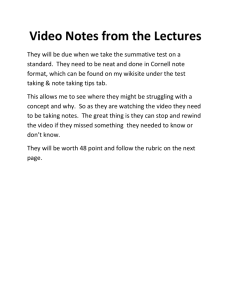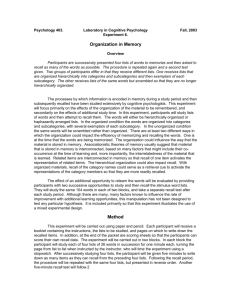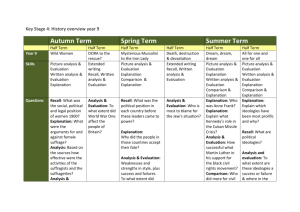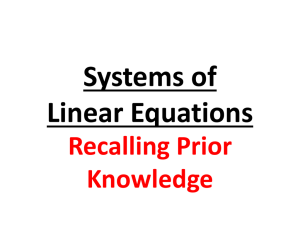Sample - Pearson Assessment
advertisement
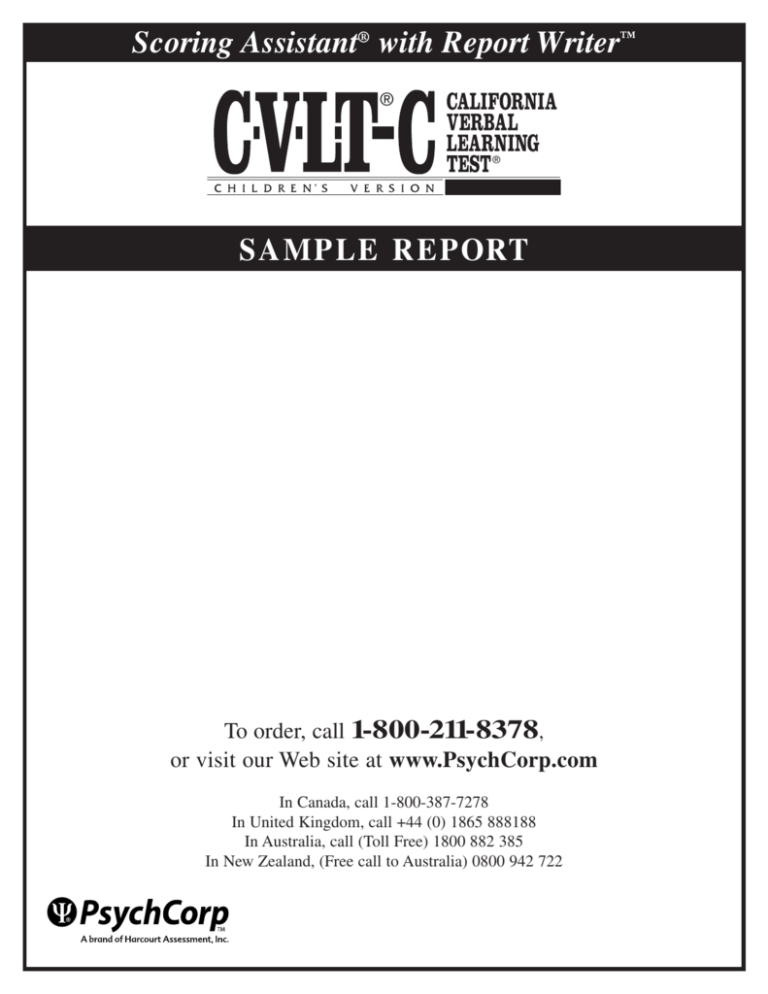
Scoring Assistant® with Report Writer™ ® ® SAMPLE REPORT To order, call 1-800-211-8378, or visit our Web site at www.PsychCorp.com In Canada, call 1-800-387-7278 In United Kingdom, call +44 (0) 1865 888188 In Australia, call (Toll Free) 1800 882 385 In New Zealand, (Free call to Australia) 0800 942 722 Child's Name: Sample Child 4 Child's Handedness: Ambidextrous ID#: 123-45-6789 Evidence of Hearing Impairment: No Age: 10 Years, 4 Months Medications: None Gender: Male Grade: 09 Examiner: A-123 School: Any Town Middle School Confidence Interval List A Total Trials 1-5: .05 Reason for Referral: None Referral Source: None Test Date: 07/02/1994 Overview of the CVLT-C California Verbal Learning Test-Children's Version (CVLT-C) measures strategies and processes involved in learning and recalling verbal material within the context of an everyday shopping task. Both recall and recognition of words are measured over a number of trials. For the first five trials, a 15-item list, List A, is read to the child and he or she is asked to recall words from the list after each presentation. A second list, List B, is then presented, and the child is asked to recall as many words from this list as he or she can. When the List B trial has been completed, the child is again asked to recall words from List A without an additional presentation of List A. The 15 words on List A are categorized as either fruits, clothing, or toys. These categories are used as cues to elicit words from the original list, for example, "Tell me all the things to wear." The CVLT-C is then set aside for 20 minutes, during which time the child completes nonverbal tasks. Following this "Long Delay" interval, the child is (a) asked to recall as many words as he or she can from List A, (b) asked to recall words from List A after being provided category cues, and (c) from a list of 45 words read aloud, asked to recognize whether or not each was on List A. Interpretive statements in this computer-generated report should be viewed as hypotheses to be integrated with professional opinions. The report is intended to assist clinicians and educators in formulating final opinions about a child's verbal learning ability, and should be viewed in context with other information, including the child's attentional skills, emotional state, physical well being, possible medication effects, social, educational, and ethnic background, and other test data. As with CVLT-C Scoring Assistant with Report Writer Version 2.0 Portions of this report are protected by copyright. Copyright © 1998 by Harcourt Assessment, Inc. all assessments, improper testing conditions and the lack of adequate student effort can compromise the validity of the CVLT-C scores. Description of Sample's CVLT-C Performance The total number of words that Sample was able to recall on all five learning trials was 60, which was superior for what might be expected compared to others his age. The following report gives an analysis of Sample's strengths and weaknesses in learning and remembering verbal material. Level of List A Learning: On the first learning trial, Sample repeated 9 of the 15 words; his performance reflected an initial auditory attention span that was superior for his age. By the fifth and last learning trial, Sample recalled 15 of the 15 words; his performance on this trial was superior for his age. Learning Characteristics: The words that make up List A are fruits, clothing, or toys. The words are mixed up so that no two words from the same category are presented consecutively. Two learning strategy scores are calculated from List A. Semantic clustering, where words from the same category are remembered together (e.g., "peaches, grapes"), is usually more effective than serial clustering, where words are remembered in the order in which they were presented. Sample's use of semantic clustering, the more effective learning strategy, was below average for his age. Sample tended not to use this active strategy for learning verbal information. Additionally, he tended to use serial clustering, a less effective strategy, more than others his age did. Active learners tend to recall words from the more difficult regions of the list, that is, the beginning and middle, while passive learners are more likely to recall words from the end of the list. Sample's recall of words was low average from the beginning of the list, average from the middle of the list, and within the expected range from the end of the list. These findings reflect a somewhat atypical pattern of recall from different regions of the list. Consistency is a measure of how well the same words are remembered on consecutive trials. The higher the consistency index, the more likely the student used some type of organizational strategy in his or her approach to learning. Sample's consistency index was high average. Learning slope refers to the average number of new words learned on each trial after the first. Sample recalled an average of 1.5 new words each time the list was presented on Trials 2 through 5. His learning slope was average. Sample's performance reflected a normal increase in the number of new words recalled from trial to trial. Interference from Previously Learned Information: Interference from previously learned information is called proactive interference. For instance, List B is usually harder to learn than List A because the List A words linger in active memory and interfere with learning List B. Sample recalled 7 out of 15 words from List B, a performance that was average. In addition, Sample's recall of List B was notably worse than his first recall of List A, indicating that he experienced an unusually high degree of proactive interference. That is, prior learning of List A interfered with learning of List B to a significant degree. CVLT-C Scoring Assistant with Report Writer Version 2.0 Portions of this report are protected by copyright. Copyright © 1998 by Harcourt Assessment, Inc. Short Delay Recall: After the List B trial, Sample was asked to recall List A again, this time from memory. He recalled 12 of 15 words, a performance that was high average compared to that of his peers. Retention (or "savings") rate refers to the percentage of words recalled on Trial 5 of List A that are also recalled after the short-delay interval. Sample's short-delay retention rate was low average compared to others his age (80.0 percent retention rate). His low retention score may reflect (a) an unusually rapid forgetfulness rate, (b) retroactive interference from List B (decremental effect on memory of List A after trying to learn List B), and/or (c) variability in Sample's ability to retrieve information from memory. On the Short Delay Free Recall trial, no help or cues are given to assist in remembering the List A words. After this trial, category cues, such as, "Tell me all the things from List A that are fruits" are given for each of the three categories. When provided with these cues, Sample recalled 10 of the 15 words, which was average for those in his age group. Compared with free recall, Sample did not benefit from the category cues relative to others his age. Sample actually recalled fewer words when provided with the category cues than when recalling words on his own. This suggests that he has difficulty using semantic strategies to remember verbal information. Long Delay Recall: At this point in the testing, the CVLT-C was set aside and nonverbal tasks were administered. After approximately 20 minutes, Sample was again asked how many words he could recall from List A. Sample recalled 13 of 15 words. His performance on this Long Delay Free Recall trial was high average. His long delay retention rate of the words that he had previously recalled on the Short Delay Free Recall trial was average (108.3 percent retention rate). Category cues were again given. Sample recalled 12 of 15 words, which was average for his age group. Compared with free recall, Sample benefited from the category cues about the same as others his age. Sample again recalled fewer words when provided with the category cues than when he recalled words on his own. This suggests that he has difficulty using semantic strategies to remember verbal information. Error Analysis on the Recall Trials: On list learning tasks, children generally make two types of errors: intrusions, words that were not on the list, and perseverations, words that have been previously mentioned on the same trial. Sample had 0 intrusions on free recall and 0 intrusions on cued recall for a total of 0, an error rate that was within the expected range for his age group. An elevated perseveration rate may suggest that a child is not adequately monitoring his recall on a trial, and, as a result, has a tendency to repeat some of the words. Sample made a total of 16 perseverative responses on all of the free and cued recall trials, which was mildly elevated for his age group. CVLT-C Scoring Assistant with Report Writer Version 2.0 Portions of this report are protected by copyright. Copyright © 1998 by Harcourt Assessment, Inc. Delayed Recognition Memory Performance: Following the Long Delay Cued Recall trial, Sample was read 45 words and asked to say "yes" if a word was from List A and "no" if it was not. The recognition list contained the 15 target words from List A (hits) and 30 distractor words (possible false Positives). Sample correctly identified 15 of the 15 List A words, a hit rate that was high average. He identified 1 of the 30 distractor words as being on the list, for a false positive rate that was within the expected range for his age group. Response bias refers to the tendency to favor "yes" or "no" answers on recognition tasks. Sample's response bias index was 0.00, indicating that he did not exhibit a strong "yes" or "no" bias on the recognition test. Recognition Discriminability is the single best recognition memory measure because it assesses the ability of a child to identify correct words (hits) relative to the ability to reject wrong words (false positives). This score can range from 100%, when the child says "yes" to all hits and "no" to all false positives, to a chance performance of around 50%. Sample's recognition discriminability of 97.78% was high average. Free Recall Versus Recognition Memory: A comparison of delayed free-recall performance with delayed recognition memory may indicate whether a student's learning problem is in encoding (the process of placing information into memory) or retrieval (the process of accessing and placing information into consciousness from long-term memory). Poor free recall with normal recognition suggests adequate ability to encode information, but inadequate ability to retrieve it. On the other hand, poor performances on both free recall and recognition tasks suggest inadequate ability to encode information. A child who has problems identifying the correct words, even when they are given to him, probably has not adequately stored the words in memory in the first place. Relative to his age group, Sample's recognition discriminability index was average compared with his performance on the Long Delay Free Recall trial. In other words, Sample's ability to recognize verbal information was about the same as his ability to recall it. Taken together, the findings suggest that Sample exhibited adequate encoding and retrieval skills in learning verbal information. Summary of Sample's CVLT-C Results Sample's ability to repeat a list of words the first time he heard it indicates a superior initial attention span for auditory-verbal information. On his fifth learning attempt, his performance was superior. In addition, his total recall of the word list across the five learning trials was superior compared to others his age. Sample's use of semantic clustering was below average compared to others his age. Additionally, he tended to use serial clustering (which is usually an ineffective learning strategy) more than others his age. Sample's recall of words was low average from the beginning of the list, average from the middle of the list, and within the expected range from the end of the list; these findings reflect a somewhat CVLT-C Scoring Assistant with Report Writer Version 2.0 Portions of this report are protected by copyright. Copyright © 1998 by Harcourt Assessment, Inc. atypical pattern of recall from different regions of the test. Sample's consistency index was high average. Sample's learning slope reflected a normal increase in the number of new words recalled from trial to trial. When presented with a second interference list, Sample's recall was average. He exhibited an unusually high degree of vulnerability to proactive interference from the first list. After a short delay, Sample's recall of the first list was high average. Category cueing failed to help Sample as much as others his age. Sample actually recalled fewer words when provided with the category cues than when recalling words on his own. This suggests that he has difficulty using semantic strategies to remember verbal information. Following a delay of about 20 minutes, Sample's recall of the first list was high average for his age. Category cueing after the long delay helped him about the same as others his age. Sample again recalled fewer words when provided with the category cues than when recalling words on his own. This suggests that he has difficulty using semantic strategies to remember verbal information. In terms of learning errors, Sample's tendency to report intrusions was within the expected range for his age on the free-recall trials and within the expected range for his age on the cued-recall trials. His total intrusion rate was within the expected range for his age. In addition, his perseveration rate was mildly elevated, indicating a slight tendency to repeat some of the words. On a delayed recognition test for the List A words, Sample's ability to discriminate between words that were on List A and those that were not was high average for his age. His hit rate was high average, and his false positive rate was within the expected range for his age group. He did not exhibit a strong "yes" or "no" bias on the recognition test. Sample's ability to recognize information was about the same as his ability to recall it. Taken together, these findings suggest that Sample exhibited adequate encoding and retrieval skills in learning verbal information. Recommendations The recommendations offered in this computer-generated report are provided as a sample of possible memory exercises that may help the student develop more effective learning strategies. The need for these or other memory exercises should be based not on a computer-generated report per se, but rather on clinical findings from multiple sources, including additions or changes to interpretations made regarding the student's CVLT-C findings, other test results, behavioral observations, and input from teachers and parents. In learning lists of words, Sample tended not to use semantic clustering as a strategy for recalling them. That is, when compared with others his age, he seldom spontaneously grouped the words into meaningful categories in order to remember them. Sample would likely benefit from learning more effective strategies for remembering verbal information. Specifically, he should be taught to think about the meaning of words when trying to remember them, and to recall words together that are close in meaning. Provide memory training drills to Sample that will enhance his use of semantic CVLT-C Scoring Assistant with Report Writer Version 2.0 Portions of this report are protected by copyright. Copyright © 1998 by Harcourt Assessment, Inc. clustering. For example, read lists of words that are similar to the CVLT-C lists in that they have words that come from a few categories. As you read the list, ask Sample to raise his hand whenever he hears words from a particular category. Repeat this procedure for different categories on the list. Then ask Sample to recall the words, explaining that words from the same category should be recalled together. He should be encouraged to use the meaning of verbal information to associate new material with that which he has previously learned. In addition, he should be encouraged to "chunk" information, that is, to group individual units of information into a smaller number of groups. For example, the number 1-3-5 could be remembered individually as three units or chunked as one unit of "one hundred thirty-five." After learning verbal material, Sample tends to forget information over time more than the average student his age does. Sample may benefit from having lessons repeated to him on different days, perhaps in condensed form, in order to ensure that this information is well-encoded into his memory. Sample should be encouraged to associate new material with previously learned material and to elaborate new concepts. For example, rather than merely repeating spelling words over and over, Sample should be encouraged to use such techniques as imagery. For example, the letters in the word "car" could be formed in such as way as to resemble a car. Sample has a tendency to repeat himself when recalling information. Provide memory drills that will encourage monitoring of recall. For instance, read a list of words and tape record his recall of the list. Next, play back the recording and instruct him to indicate whether he repeated a word. CVLT-C Scoring Assistant with Report Writer Version 2.0 Portions of this report are protected by copyright. Copyright © 1998 by Harcourt Assessment, Inc. To find out more, call 1-800-211-8378, or visit our Web site at www.PsychCorp.com In Canada, call 1-800-387-7278 In United Kingdom, call +44 (0) 1865 888188 In Australia, call (Toll Free) 1800 882 385 In New Zealand, (Free call to Australia) 0800 942 722 Harcourt Assessment, Inc. 19500 Bulverde Road, San Antonio, Texas 78259-3701 Copyright © 2005 by Harcourt Assessment, Inc. “Scoring Assistant,” “CVLT,” and “California Verbal Learning Test” are registered trademarks of Harcourt Assessment, Inc. “Report Writer” is a trademark of Harcourt Assessment, Inc. “Windows” is a registered trademark of Microsoft Corporation “Macintosh” is a registered trademark of Apple Computer, Inc.



